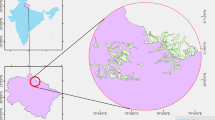Abstract
The features of physical geography in the transitional region between Qinling Mountains and Huanghuai Plain possess transitional characters evidently in two directions: one is from the western mountain to the eastern plain and the other is from southern subtropical zone to northern temperate zone. Torrential rain, especially strong torrential rain is frequent in the transitional region, and there are many torrential rain centers. A majority of torrential rain is distributed among 100–200 m asl. The winter temperature at 100–400 m asl is higher than that in Huanghuai Plain whose altitude is lower than that of the transitional region, and the highest temperature in January appears at 350–400 m asl. The thickness of warm slope belt in the transitional region varies from 100 m to 250 m asl. The formation of torrential rain and warm slope belt is the result of joint action of atmospheric circulation and local terrain. Frequent torrential rains and warm slope belt had tremendous influences on the soil properties, plant distribution and local climate in the transitional region.
Similar content being viewed by others
References
Ai Nanshan, 1987. The information entropy of geomorphic system in erosion drainage basin.Journal of Soil and Water Conservation, 1(2): 1–7. (in Chinese)
Ai Nanshan, Yue Tianxiang, 1988. Another discussion on the information entropy of geomorphic system in erosion drainage basin.Journal of Soil and Water Conservation, 2(4): 1–7. (in Chinese)
Fu Baopu, 1982. The calculation of climate elements in mountainous areas.Journal of Meteorology, 40 (4):453–463. (in Chinese)
Fu Baopu, 1983. Mountain Climate. Beijing: Science Press, 122–137. (in Chinese)
Fu Baopu, Yu Jingming, Lu Qiyai, 1996. Climate Resource in Mountain and Its Exploitation and Utilization. Nanjing: Nanjing University Press, 198. (in Chinese)
Guan Hua, 2002. Distinguishing of the geomorphic evolution stage with information entropy in the transitional region between Qinling Mountains and Huanghuai Plain.Scientia Geographica Sinica, 22(6): 671–676. (in Chinese)
Hu Yi, Wang Zhong, Yin Xiaoyiet al., 1994. Study on warm zone and its law on east and west slope of Ailao Mountain.Journal of Chengdu Institute of Meteorology, 9(2): 43–50. (in Chinese)
Li Kehuang, 1981. The temperature field of Funiu Mountain and the north boundary of subtropical zone.Journal of Henan Normal University, 11(2): 43–55. (in Chinese)
Li Kehuang, Guan Hua, Ma Jianhua, 1996. Theory and Practice of Transitional Region of Physical Geography. Beijing: China Agricutural Press, 191–212. (in Chinese)
Li Juxin, Liu Shugui, 1986. Ecological environment and selection of sites suitable for citrus planting in Xichuan County, Henan Province.Journal of Geographical Sciences, 41(2): 184–190. (in Chinese)
Lin Mao, 1977. The air temperature inversion and vegetation invert.Meteorology, 3(1): 16–18. (in Chinese)
Ma Jianhua, 1995. A preliminary study on the map of soil types using TM images.Regional Research and Development, 14(1): 81–85. (in Chinese)
Ma Jianhua, 1997. Study on the migration and accumulation laws of soil materials in the transitional region between Qinling Mountains and Huanghuai Plain.Mountain Research, 15(1): 36–41. (in Chinese)
Ma Jianhua, 2004. The influence of torrential rain on soil components and properties: a case study of Biyang central area of torrential rain.Geographical Research, 23(1): 55–62. (in Chinese)
Ma Keyang, Liu Yuhong, Ma Youxin, 1995. Characteristics of temperature inversion in Ailao Mountain.Mountain Research, 13(2): 91–97. (in Chinese)
Miao Dong, Liu Junchen, 1997. The warm slope belt and the conditions for agricultural production.Meteorology of Henan, 27(3): 25–26. (in Chinese)
Pan Shouwen, 1984. The progress in mountain climate research of China. In: Editorial Board of Collected Papers on Mountain Climate, Collected Papers on Mountain Climate. Beijing: Meteorology Press, 1–7. (in Chinese)
Quan Shilin, Si Ximing, 1984. The methodology approach of determining the boundary between subtropical zone and temperate zone in East China.Journal of Henan Normal University, 14(1): 39–49. (in Chinese)
Qian Huaisui, Li Mingxia, 1992. The impacts of landforms on precipitation in the transitional region between Qinling Mountains and Huanghuai Plain.Geographical Research, 11(3): 84–88. (in Chinese)
Roger G Barry, 1981. Mountain Weather and Climate. New York: Mcthuen.
Shi Qiren, 1993. Study on the heat resources of Qinling Mountains and Huanghuai Plain.Journal of Henan Normal University, 23(4): 1–6. (in Chinese)
Shi Qiren, 1984. Study on the calculation methods of temperature in the warm slope belt and mountains without gauging station. In: Editorial Board of Collected Papers on Mountain Climate, Collected Papers on Mountain Climate. Beijing: Meteorology Press, 40–41. (in Chinese)
Wang Lipu, 1984. The mountain temperature inversion in the south of Yunnan Province. In: Editorial Board of Collected Papers on Mountain Climate, Collected Papers on Mountain Climate. Beijing: Meteorology Press, 126–128. (in Chinese)
Wang Ling, Jiang Ailiang, Chen Xiaolin, 1987. A simple analysis of the mountain temperature inversion in south-subtropical belt of China.Mountain Research, 5(3): 136–142. (in Chinese)
Yoshino M, 1981. Formation of a cold air lake and its effects on agriculture.Journal of Natural Disaster Science, 3 (2): 1–4.
Zhang Guangye, Zhou Huashan, Sun Xianzhang, 1985. Geomorphic regionalization in Henan province. Zhengzhou: Henan Science and Technology Press, 1–14. (in Chinese)
Zhang Jinquan, 1981. Study on the boundary between subtropical zone and warm temperate zone in Henan Province according to geo-botany.Acta Geographica Sinica, 36(2): 216–222.
Zhong Zhaozhan, Li Kehuang, 1996. A primary study on the climatic boundary effect of the transitional region between Qinling Mountains and Huanghuai Plain.Geographical Research, 15(4): 66–73. (in Chinese)
Author information
Authors and Affiliations
Rights and permissions
About this article
Cite this article
Jianhua, M., Jian, L. & Huaisui, Q. The features of physical geography in the transitional region between Qinling Mountains and Huanghuai Plain. J. Geogr. Sci. 14, 437–446 (2004). https://doi.org/10.1007/BF02837487
Received:
Accepted:
Issue Date:
DOI: https://doi.org/10.1007/BF02837487




